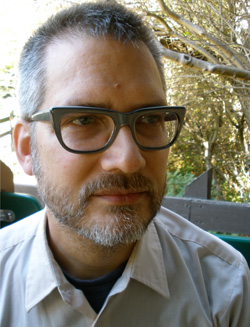LIVERMORE, Calif.— Sandia National Laboratories combustion chemist Craig Taatjes, whose groundbreaking work on Criegee intermediates has provided scientific insight into hydrocarbon combustion and atmospheric chemistry, has been selected to receive the prestigious Polanyi Medal by the International Symposium on Gas Kinetics.
Taatjes will receive the award and present the Polanyi Lecture at the 23rd International Symposium on Gas Kinetics and Related Phenomena from July 20-24, 2014, in Szeged, Hungary.

The Polanyi Medal is awarded every two years. The recipient is chosen by the Committee of the Gas Kinetics Group of the Faraday Division of the Royal Society of Chemistry, and is someone who has made outstanding contributions to the field of gas kinetics. The Polanyi medal is named after professor Michael Polanyi, 1891-1976, whose research helped to define the modern subject of gas kinetics and reaction dynamics.
“The list of previous recipients of this award includes some of my greatest scientific mentors and role models,” said Taatjes. “So it is a surprise and a tremendous honor to now be listed among them.”
Taatjes said he has been “exceptionally fortunate to work with generous and brilliant co-workers at Sandia” and external collaborators. He cited his Sandia colleague David Osborn, who led the development of the machine that enabled Criegee intermediates to be probed, and Argonne National Laboratory’s Stephen Klippenstein. “Without colleagues like them and my excellent postdoctoral associates, I would not have been able to carry out the work that this award recognizes,” said Taatjes.
During his distinguished career at Sandia, Taatjes has carried out research aimed at understanding the fundamental chemistry of combustion and hydrocarbon oxidation, including flame measurements and the reactions that govern low-temperature autoignition.
Recently, he led a project that made the first direct measurements of the reactions of Criegee intermediates, formed in ozone-initiated oxidation of hydrocarbons, showing that their impact on tropospheric chemistry and climate may be substantially greater than previously assumed. Through funding by the Department of Energy’s Office of Science, Taatjes and his research team conducted studies of gas phase Criegee intermediates using Sandia’s multiplexed photoionization mass spectrometer (MPIMS) at the Advanced Light Source, a scientific user facility also supported by the DOE.
Though the atmospheric importance of these Criegee intermediates has long been postulated, this was the first direct measurement of the rates and products of their reactions. The groundbreaking work was published in January 2012 in Science magazine, and in a follow-up paper in the April 2013 edition of Science.
Taatjes works at Sandia Labs in Livermore, Calif. He received a doctorate in chemical physics from the University of Colorado-Boulder and a Bachelor of Science degree in chemistry from Calvin College in Grand Rapids, Mich. Among other awards and honors, he is a fellow of the American Physical Society, a two-time winner of the David A. Shirley Award, an O.W. Adams Award winner for outstanding achievement in combustion science, and a Lockheed Martin Corp. NOVA award winner for Individual Technical Excellence. He has authored or co-authored more than 120 peer-review publications and has given more than 50 invited lectures.